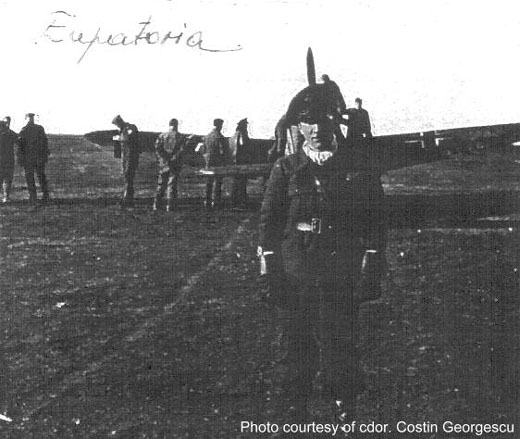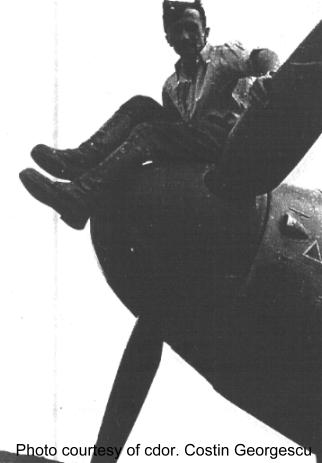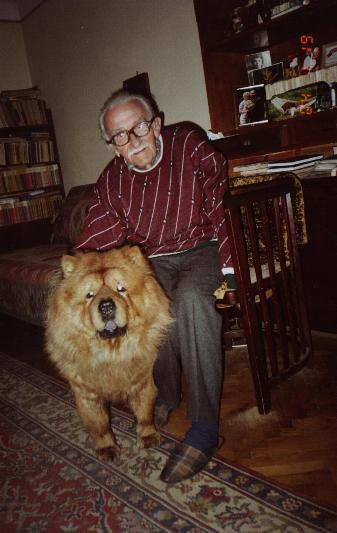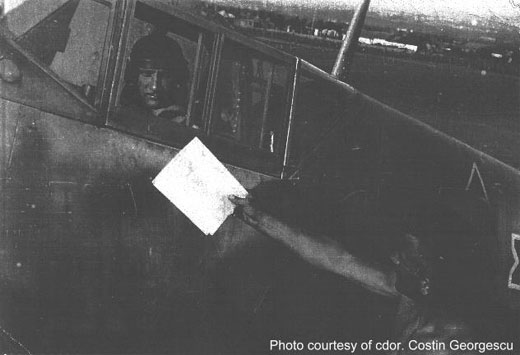
Picture courtesy of cdor. Costin Georgescu
Slt. av. Costin Georgescu at Yevpatoria in 1943
This interview was taken by Claudiu Stumer in October 2003
Claudiu Stumer: Present yourself, please!
Costin Georgescu: I am 85 years old, I was born at Albesti, Moldavia, in 1918. When I was 5 years old, we moved to Constanta, where I graduated the first 6 grades. Then my father had to move again, because of his job, to Bucharest, where I went to the "Mihai Viteazul" High School. After graduating from high school, my childhood ended and my real life began. I was admitted into the Air Force Officer School.
Claudiu Stumer: Why did you choose the air force?
Costin Georgescu: Because I loved the airplanes since I was a kid. I used to build model aircraft. My dream was to become an aircraft designer, but I could not follow it, because I wasn't that good at math. So, my only chance of being close to the airplanes was to become a pilot. Between 1939 and 1941 I went to the Air Force Officer School and graduated with the rank of 2nd lieutenant, on 10 May 1941. The flying courses were at Otopeni and then, because of the war, at Targu Jiu. We stayed there until October, when we were moved back to Bucharest, where we had some aerial observer courses. At the end of December we were sent to the units inside Romania. I was assigned to the 3rd Fighter Flotilla at Galati.
There we continued the training and because I drew very well, the flotilla's CO, "Mache" Marasescu, gave me the task to make several boards with aerial tactics, which were later hanged in the flotilla's conference room. Thanks to this task I had some privileges and did not have to attend all the recruit training, only the flight training, from January to April.
There was a small incident, which could have finished really badly, but I managed to get away in one piece (and also an intact airplane), thanks to my reflexes. It was winter and our PZLs were equipped with skis. I took off and flew over the airfield several times. At my fourth pass, I started to descend and the engine stopped. I managed to turn the airplane around and land on a field close to the city, between two trees.
Claudiu Stumer: What happened?
Costin Georgescu: The airplane had a small tank for starting the engine. This was done by the mechanic on ground, who did not mention anything about it to me. So after 10 minutes, the fuel was over.
During the summer [1942] I was reassigned to the 43rd Fighter Squadron at Odessa, CO cpt. av. Ioan Ignat. We flew fighter cover missions for the naval bases on the Black Sea shore. In September we went to Brasov where in two weeks converted to the IAR-80. There I met my wife, to whom I have been married for 59 years.
We returned to Odessa and then we were relocated to Kerch, in Crimea. We protected the convoys that passed through the straits. We were under German command, with which we had no problems. On an airfield near us there was a Slovakian squadron. During an inspection of that unit, our CO was also invited. Gen. von Richtoffen asked him what we required and he said that we wanted better airplanes. And in spring we received Bf-109s!

Picture courtesy of cdor. Costin Georgescu
Slt. av. Costin Georgescu sitting on the nose of his Bf-109G
We were moved to Eastern Crimea for training on the new aircraft and, after one month, in April, we went to Tiraspol. The 109s we had received had been intensively used and were only suited for training. This is why I was sent with a couple of NCOs to Odessa, where there was a Bf-109G-2 depot. There we met three German pilots: one officer, decorated with the Knight's Cross, and two NCOs. I spoke German and talked with them. They were from a Fw-190 unit and were converting to 109s, because the Focke-Wulf was better suited to ground attack. They climbed in their airplanes and, at take off, they broke two of them. The problem was that the aircraft deviated strongly to the left and if one did not correct the direction with the rudder, one could find himself in rather delicate position. Then we took off without incidents. I have to mention the fact that at Yevpatoria, we also broke two 109s for the same reason. Nobody told us what to do. It could have happened to very experienced pilots, if they were caught by surprise.
At Tiraspol, after we received the new airplanes, we continued the training until June. Then we had to take part in the general maneuvers at Kirovograd, to which marshal Antonescu also was going to attend. On the road, I got lost, as I was part of the last formation. The red light, which indicated that there was fuel only for ten more minutes of flight, was on. I decided to land and spotted a pasture nearby. I flew over it at low altitude, in order to scare the cows, which were grazing there. They cleared the "runaway" immediately and I managed to land safely, without damaging the airplane, which, by the way, had only 20 hours. The pasture was located near a nice village, Scora, which was surrounded by a small forest and a small lake. Several German gendarmes arrived immediately. From them I found out that there was a German airfield nearby and I phoned to Kirovograd and reported the situation. A lieutenant came with a Storck [F-156]. The problem was that the airplane had lost glycol. We took water from the pond and managed to fill the radiators. The lieutenant took off with the Bf-109 and I with the Storck.
The following day, at Kirovograd, the maneuvers went on very well: fighters, assault aircraft, bombers. The entire Romanian Air Corps in Russia. We went back to Tiraspol. Several days later, the 7th Fighter Group was moved to Mariupol. We flew bomber escort missions, free-hunting missions, escort for German reconnaissance airplanes. In August, we moved closer to the front line, at Kramatorskaya. There we were attacked very often by Il-2s, but they did not provoke too much damage. On the contrary we generally managed to shoot down quite a few of them.

cdor. av. Costin Georgescu with his beatiful Chow-Chow
On 17 August, during an assault aircraft escort mission, an AAA shell exploded in my left arm, which fell out of the airplane. Initially, due to the shock of the explosion, I did not realize what has happened. I was a little dizzy and felt a burn in shoulder. I could not hear the engine and had the impression that all was over and I was going to die. The shell also destroyed the instruments, not only my arm. The airplane was loosing altitude and I could not hear the engine. My first thought was to tryto make an emergency landing. But for this I needed the engine. I took the stick and managed to level the airplane and then I throttled up to 100%. There was only one thing in my mind: to land! I knew that near Slaviansk there was an area suited for a crash landing and headed there. In the meantime I turned off all electrical contacts and descended. I turned the engine off, but could not use the flaps, because I could not let go of the stick (for the flaps I would have required my left hand). I had 300 km/h and the airplane did not want to land. I pushed the stick, until the propeller blades hit the ground. I finally touched down and the aircraft stopped after 30 m. I got out and lay down. Except for the propeller, it was fine.
Several German soldiers from the Todt Organization were working nearby and they came
quickly with a stretcher and a truck. I was taken to a field hospital. There, after seeing
the line of hundreds of wounded waiting to be treated, I started to cry. A Finnish nurse
came and took me in front of the others. The surgeons had only to cut away a tendon that was
hanging and to bandage me. I awoke in a hospital bed, in the middle of other wounded or
dying, who were crying in pain. My arm did not hurt at all. I requested to be transferred to
another hospital and the next day a car took me there. I received a large box of chocolates
from... Adolf Hitler with thanks!  .
.
I was very well treated, but remained only for one day, because there was a Ju-52 that was taking wounded to a Romanian hospital. There I was visited by Bazu Cantacuzino, with whom I had a small fight the night before I was shot down (I imitated him and he got upset). The hospital was very nice and clean, but the mattress was made of straw and this made sleeping quite difficult. I spoke with the doctor and I found out that there was a train leaving for Romania. It was full with wounded on stretchers. We left during the evening. We were attacked during the night by Po-2s, which sounded more like motorcycles. After one day we arrived at Iasi. I was well treated there. I sent a cable home and my father came with the first train. I went to Bucharest with him and was interned in the 327th Hospital. There I met Dicezare who had just been operated at the spine. A very complicated procedure, even today. But it was a success and he is fine even today. I was also operated several times there, in order to speed up the healing.
Claudiu Stumer: How come you did not bleed to death until you got to the hospital?
Costin Georgescu: The time interval was about 20 minutes. The explosion of the shell must have cauterized the veins.

Picture courtesy of cdor. Costin Georgescu
Slt. av. Costin Georgescu in the cockpit of his Bf-109G
[comments are mine - Victor Nitu]
Check out Costin Georgescu's profile in the pilots section. Here
@ 2002-2003